1 December 2022: The nature and size of platinum above ground stocks now locked up in China combined with the 2023 forecast deficit could materially impact price discovery: China’s significant excess platinum imports since 2019 have resulted in a flow of metal out of Western vaults and into China and in 2020 and 2021 match or exceed the platinum market surpluses estimated for 2021 and forecast in 2022. The timing of China’s platinum purchases has been highly price opportunistic, which suggests that there is a quasi-speculative component to them. However, there has also been a step-change in total volumes since early 2021, indicating that there may also have been an increase in real demand. The concentration of above ground stocks in China leaves limited excess inventory in the rest of the world to meet any market imbalances, such as the 303 koz deficit forecast for 2023. This, in combination with higher prices likely being needed to release Chinese inventories to the domestic market, could have a significant bearing on platinum market price discovery.
Platinum Perspectives
WPIC® research is free of charge. It can be consumed by asset managers under MiFID II
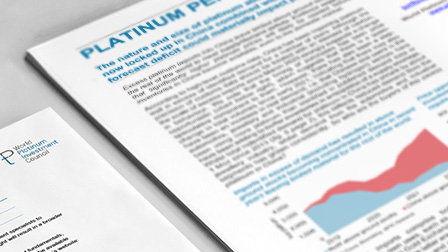
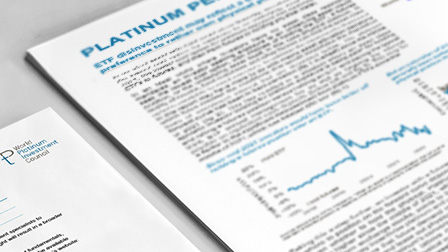
1 November 2022: ETF disinvestment may reflect a change in investor preference to rather own physical platinum: In an ideal world with total asset class flexibility, investors would choose the lowest cost option for exposure to an underlying asset. Since mid-2021, the lowest cost option for platinum exposure has switched first from ETFs to futures, and then from futures to holding physical metal. Indeed, backwardation in the platinum forward curve means investors would effectively be being paid to hold a futures position in platinum, and for some investors the attraction to own and lease out physical platinum may have been even more compelling given significantly elevated platinum lease rates. This may be a factor in the significant disinvestment from platinum ETFs since the middle of 2021, which has totalled 850 koz.
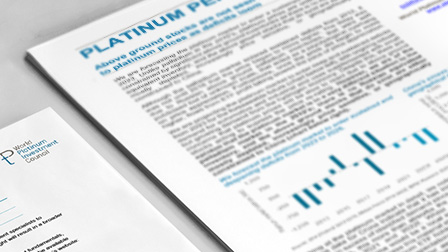
1 October 2022: Above ground stocks are not seen as a major headwind to platinum prices as deficits loom: We are forecasting the platinum market to enter sustained deficits from 2023. Unlike palladium in the 2010’s, the platinum price is unlikely to be constrained by significant above ground inventories as there is no equivalent to the Russian palladium inventory, and what above ground platinum stocks exist are either mostly depleted, increasingly price sensitive, or geographically constrained to China. China’s excess platinum imports has created tight physical market conditions, which are illustrated in high lease rates; something that was not true of palladium when it entered sustained deficits.
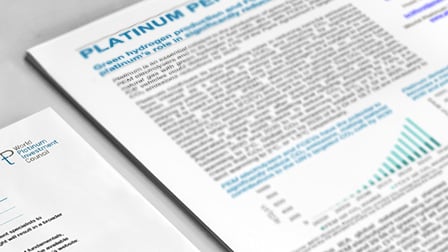
1 August 2022: Green hydrogen production and FCEV usage highlight platinum’s role in significantly reducing CO2 emissions: We estimate that PEM electrolysers operating on renewable energy could generate between 9 Mt and 29 Mt of green hydrogen per annum by 2030, dependent on the PEM portion (31%-96%) of all installations. We calculate that this range of hydrogen production displacing a combination of natural gas and internal combustion engine vehicles with FCEVs would result in cumulative CO2 savings of between 0.24 Gt and 0.63 Gt. At the lower end of this range, this equates to 1% of the savings needed to meet the Paris Agreement’s targets of limiting warming to 1.5°C, whilst at the top end of the range it equates to 11% of the reductions needed to limit warming to 2°C. Whilst the percentage contributions might at first glance appear small, they highlight the scale of CO2 emissions cuts that are needed, and that the CO2 emissions avoided thanks to green hydrogen are in fact meaningful. Annual platinum demand in 2030 from FCEVs and electrolysers, dependant on the PEM portion, would be between 1.6 Moz and 2.4 Moz.
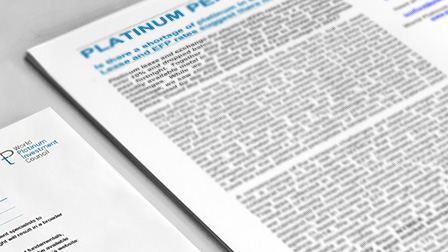
1 May 2022: Is there a shortage of platinum in the spot market? Lease and EFP rates suggest there may be: Implied platinum lease and exchange for physical (EFP) rates have spiked to over 10% and dropped below negative US$20/oz respectively in the past fortnight. Together they suggest that there is a shortage of readily available metal in the spot market, possibly due to logistical challenges. While we do not know the exact reason behind the shortage, we saw similar moves in 2020 due to severe COVID-related transport disruptions, exacerbated by the ACP converter failure which led to a 12-month uplift in platinum prices. Could the Russia question be the ACP outage of 2022?
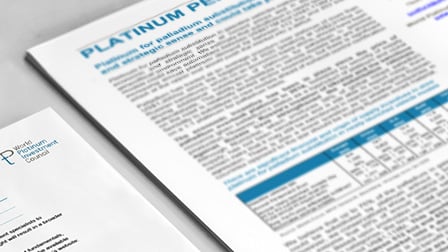
1 April 2022: Platinum for palladium substitution makes economic and strategic sense and could take platinum into deficit: Platinum for palladium substitution in gasoline vehicles makes compelling economic and strategic sense at current prices and in the current geopolitical environment. Russia’s invasion of Ukraine and the retaliatory sanctions enforced against Russia has cast a stark light on the 38% of global mined palladium supply that comes from Russia. Although Russia’s palladium exports are not yet subject to sanctions, this could change at any time. We estimate that substitution in newly launched models could save automakers between US$671M and US$1,118M p.a., increasing annual platinum demand by between 512 koz and 853 koz, which at the upper end would push the market into a deficit.
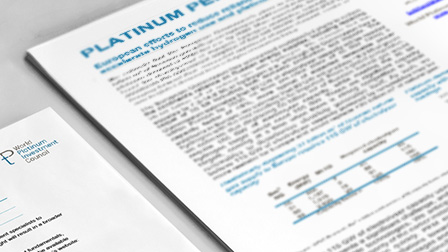
1 March 2022: European efforts to reduce reliance on Russian gas will accelerate hydrogen use and platinum demand: We estimate that the European Commission’s plans to replace 25-50 billion m3 of Russian gas with green hydrogen could result in incremental platinum demand of ~240 koz p.a. by 2030. Whilst the motivation is mostly strategic, we note that green hydrogen is also cost competitive at current, albeit inflated, natural gas prices. It would also boost the development of Europe’s hydrogen production capacity and accelerate the commercial adoption of fuel cell electric vehicles (FCEV), bringing forward their associated significant platinum demand, similar in size to global demand from catalytic converters today.
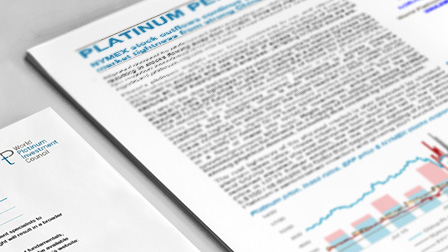
1 February 2022: NYMEX stock outflows continue to respond to physical market tightness from strong China imports: Ongoing platinum imports into China during 2021 were c.1.4 moz higher than its published demand requirements and well in excess of the estimated global platinum surplus of 769koz. This has caused tightness in the physical market, putting the platinum market into backwardation and creating an arbitrage, incentivising market participants to access cheaper NYMEX stocks to deliver into the higher priced European spot market. As a result, NYMEX stocks have continued to shrink from the highs reached in 2020 when COVID-choked logistics significantly increased market-making risks. Without an identified demand end use, excess China imports are not captured in our supply/demand analyses, yet falling NYMEX stocks are, distorting the supply/demand balance versus the tight market conditions.
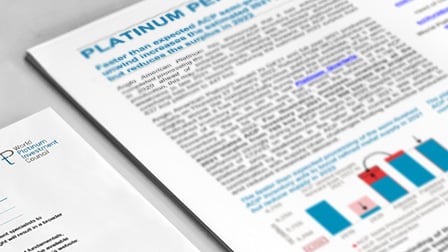
15 January 2022: Faster than expected ACP semi-processed inventory unwind increases the estimated 2021 platinum surplus but reduces the surplus in 2022: Anglo American Platinum has announced that it has substantially completed processing the semi-finished ACP inventory overhang created in 2020 ahead of schedule. Combined with restricted automotive production and reduced investment demand, this additional refined platinum flowing into the market may have contributed to platinum price weakness in the latter part of 2021. Importantly, looking forward, the ACP inventory overhang has been removed, reducing the estimated 2022 platinum surplus from 637 koz to 447 koz.
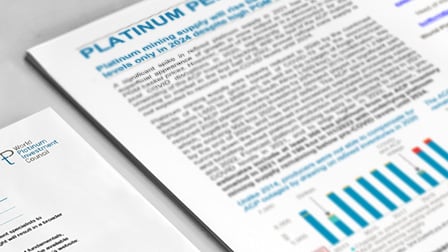
1 January 2022: Platinum mining supply will rise back to pre-COVID levels only in 2024 despite high PGM basket prices: A significant spike in refined platinum supply in 2021 has given the superficial appearance of growth in mine output in response to higher PGM basket prices. However, most of the increase is a recovery in output post COVID disruptions in 2020, significantly supplemented by the unwinding of the ACP semi-finished inventory backlog. With the last of the ACP material coming to market in the first half of 2022, annual refined mine supply is not expected to recover to pre-COVID levels until 2024.
